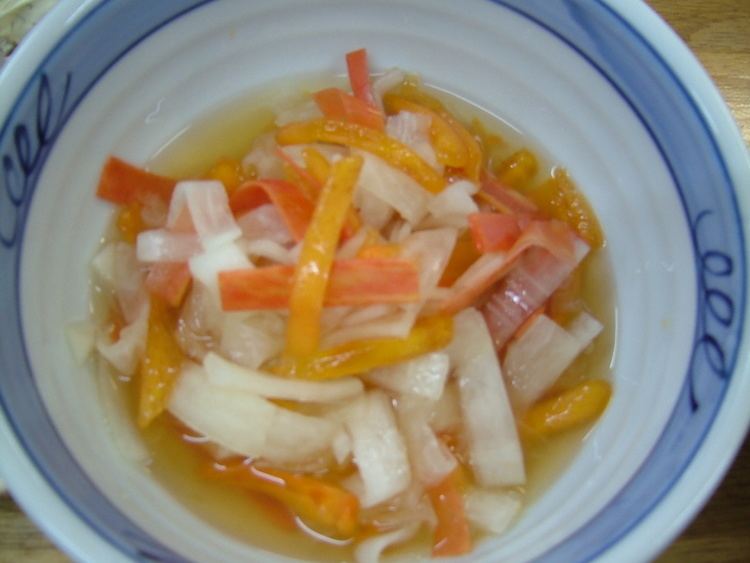Traditional Chinese 膾 Hanyu Pinyin Hokkien POJ kòe | Simplified Chinese 脍 Yale Romanization kui2 | |
 | ||
Similar Osechi, Sashimi, Zōni, Sushi, Miso soup | ||
Kuai (Chinese: 膾; pinyin: kuài) was a Chinese dish consisting of finely cut strips of raw fish or meat, which was popular and commonly eaten in the early history and dynastic times of China. According to the Book of Rites (禮記) compiled between 202 BC–220 AD, kuai consists of small thin slices or strips of raw meat, which are prepared by first thinly slicing the meat and then cutting the thin slices into strips. In modern times, the dishes are more often referred to as "raw fish slices" (Chinese: 生魚片; pinyin: shēngyú piàn) or as "yusheng" (魚生, yúshēng). Commonly used fish in ancient times include carp (鯉) and mandarin fish (鳜), but salmon (鮭) is also used in modern times.
Sauces were an essential part of kuai dishes, with green onions used for preparation of sauces in spring and mustard seed used for sauces in autumn (膾,春用蔥,秋用芥, Book of Rites). According to many classical texts, kuai served without sauces was deemed inedible and should be avoided (不得其醬不食, Analects).
History
Raw fish and meat dishes, know collectively as kuai, were first documented in China in the Zhou Dynasty (1045–256 BC), and are mentioned in the Shi Jing, Classic of Rites, Analects of Confucius, and Mencius. A related preparation method is xuan (軒), which involve slicing the raw meat in large thin pieces in the manner of carpaccio, however the term "kuai" was used to refer to this method. Kuai is the preferred preparation of raw beef and lamb, or fish such as the carp, while meats from wild deers and boars were prepared as xuan. Thinness in the slices or strips was an important factor for judging the quality of the dish (膾不厭細, Analects). During this dynasty and the ensuing Warring States period kuai made from all fauna were widely consumed.
During the time of the Qin (221–206 BC) and Han Dynasties (206 BC–220 AD) kuai made from the meat of land fauna became less popular with the term used to refer more and more to thinly slice raw fish. The dish was widely consumed by all classes and coincides with the appearance of the character "鱠" (kuai) with its fish radical (魚) during this period (alongside the character 膾 with the "" meat radical). In addition, characters such as "燴" (kuai) with the fire radical were introduced to indicate fish that has grilled to the rare stage and then thinly sliced, similar to Japanese Tataki. Indeed, kuai and raw fish were so commonly consumed that Ying Shao(應劭) in his Fengsu TongYi (風俗通義), a manuscript that described the odd and exotic practices of various cultures and peoples, stated that "In Zhu-A, raw fish is not consumed" (祝、阿不食生魚, chap. 釋忌), alluding to the perceived oddity of not eating fish raw. It is also during this period that the renowned dish jinji yukuai (金齏玉膾) along its accompanying baheji sauce (八和齏) was created (齊民要術 Qi Min Yao Shu, scroll 8).
Although the dish was not widely consumed during later dynasties in China, it enjoyed a very high status in Chinese cuisine. Chinese physicians of the time sometimes recommended against it due to the very real possibility of serious illness due to flukes and other parasitic organisms, however many prominent Chinese individuals (including Cao Zhi and Chen Deng) maintained a strong affinity for the dish. It was believed that the application of strongly flavored spices such as mustard or Sichuan pepper could render the dish safe to consume.
Consumption of kuai in China declined sharply by the time of the Qing Dynasty. Since that time, most Chinese food has been cooked, though a Chaozhou dish called yusheng uses raw fish as its primary ingredient.
